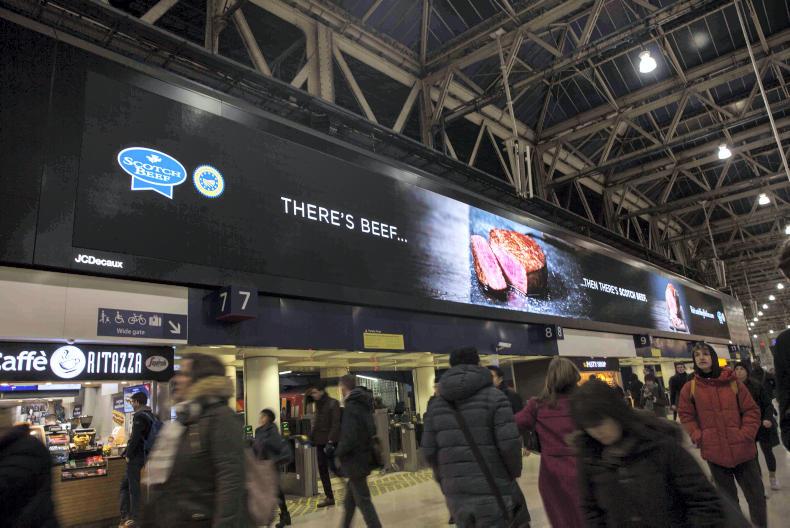The recent marketing campaign behind Scotch Beef PGI has delivered strong results for the Scottish red meat industry.
The focus of the two-month campaign, run by Quality Meat Scotland (QMS), was to build awareness and trust in Scotch Beef PGI in the target markets of London, the home counties and Scotland, reinforcing the message that it is the best beef money can buy.
Analysis by independent market research organisation, Kantar Worldpanel, revealed that the campaign contributed to a 7% increase in the volume of retail sales of identified fresh Scottish-origin beef in the past 52 weeks – ending 22 April 2018. It also revealed that in London, fresh Scottish-origin beef maintained an average price differential of 10% over home-produced beef – ie shoppers were willing to pay 10% more.
During the past year the penetration of fresh Scottish-origin beef in the GB market also increased by 6.3%, with volume increasing 7% across GB in the 52-week period ending 22 April 2018.
The campaign aimed to re-engage consumers and provide contemporary alternatives to traditional roast dinner serving suggestions. Its strapline – “There’s beef…then there’s Scotch Beef” – showcased Scotch Beef and the flavour, provenance and integrity which underpin the brand’s PGI status.
Over 8.2 million consumers were targeted across GB during March and April via press, digital, broadcast and billboard advertising, to inform, educate and inspire them to use Scotch Beef when they cook.
Together, the use of digital screens across London and advertising spaces outside retailers reached 44 million people.
A radio campaign on Classic FM also reached 1.1m people making the brand stand out to listeners when it co-branded the station’s “best of” feature.
Innovative recipes were also showcased in titles such as Good Housekeeping and Country Living, to celebrate the quality and creativity of the modern roast. The branded activity built coverage and aimed to inspire households in the lead up to Easter Sunday.
Carol McLaren, director of marketing and communications with QMS, said that the results confirmed that the campaign had delivered strongly for the industry.
Carol said: “One very encouraging result from the figures, looking at pre-campaign and post-campaign, is that there is a considerable increase in the number of shoppers – 43% compared to 29% – who agreed they were more aware of the Scotch Beef PGI logo.
“We also saw an increase (42% v 32%) of people within our London target market who agree they would pay more for Scotch Beef. These are promising results for the campaign and for our industry.”
Agricultural organisations from England, Scotland and Wales are uniting in a new initiative which will see them work together to communicate the benefits of red meat in a balanced diet as part of a reinforced meat and health programme.
QMS, Hybu Cig Cymru (HCC) Meat Promotion Wales and the Agriculture and Horticulture Development Board (AHDB) are uniting behind a jointly-funded programme of activity to collectively raise consumer awareness of red meat’s positive messages.
The initiative is being financed as part of a £2m fund of AHDB red meat levies ring-fenced for collaborative projects. This interim arrangement is in place while a long-term solution is sought on the issue of levies being collected at point of slaughter in England, for animals which have been reared in Scotland or Wales.
AHDB has, for some time allocated resources to the Meat Matters programme, which has included input and funding from Beef + Lamb New Zealand, Danish Agriculture and Food Council, Livestock and Meat Council Northern Ireland and Ireland’s Bord Bia, on consumer messaging, which will continue alongside the core programme.
The 2018/19 programme of shared activity, involving QMS and HCC, kicked off this month and will see a greater focus on proactive campaigns aimed at providing consumers with balanced and evidence-led advice on the role that meat can play in a healthy, balanced diet.
“There is a wealth of evidence to demonstrate that red meat is packed with nutrients such as zinc, B vitamins and potassium,” said Christine Watts, chief marketing and communications officer at AHDB.
“Despite this, consumers are often duped by pseudo-science or ill-informed and sensationalist reporting encouraging them to cut down on their meat consumption or cut it out altogether. This can be highly dangerous, especially for certain groups who are deficient in vital nutrients such as iron.
“This industry has a great story to tell, not just in terms of nutrition, but in terms of sustainability and environmental harmony. This reinvigorated programme will help to get these messages to consumers enabling them to make an informed and balanced choice.”
Core to the refreshed activity will be the Meat Advisory Panel (MAP) which is comprised of third party, authoritative doctors, surgeons and nutritionists advocating red meat in the diet. MAP also works to debunk many of the myths associated with red meat consumption.
Carol McLaren, director of marketing and communications at QMS, said: “Farmers and others working at each step of the red meat production chain take huge pride in the care and commitment which goes into producing a safe and nutritious product.
“This new programme of activity offers an excellent opportunity to work closely with our sister organisations in England and Wales to collectively raise the profile of red meat’s positive health and sustainability messages.”
Rhys Llywelyn, market development manager at HCC, said: “HCC is delighted to be a key part of this collaborative programme.”
“There is a very positive story to tell about how red meat can form a naturally nutritious part of a balanced diet. It’s important that the industry is on the front foot and making the case for the many health benefits of lamb, beef and pork.”
Work from the programme will also feed into wider international organisations, including the International Meat Secretariat, to ensure consistent messaging on meat and health issues is shared around the globe.






 This is a subscriber-only article
This is a subscriber-only article











SHARING OPTIONS: